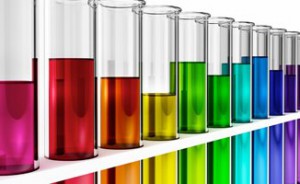At La Deessa we hope to dispel online cosmetic ingredient myths and misconceptions by separating fact from fiction:
It is important to us that you feel confident in the safety and efficacy of every one of our ingredients. Extensive research goes into each ingredient and the overall formulation of each product, followed by comprehensive testing before we offer it to the public. Rest assured, we wouldn’t offer anything to you that we don’t feel completely confident using ourselves or having our friends and family use!
At La Deessa endeavor to offer you premium products that are natural and organic while also being safe and stable. Natural ingredients, however, can have variances in their properties or concentrations. This is particularly important for preservatives, as variability in the properties or concentrations of a natural preservative could cause a product to become easily contaminated, compromising the formulation and resulting in unintended outcomes. That said, La Deessa offers natural, organic as well as some synthetic ingredients in some of our product offerings.
We believe in full disclosure. Some companies will only feature “Active” or “Key” ingredients in their product listings, leaving out their non-active synthetic compounds. Rest assured that all “active” ingredients will always be 100% natural and we will strive to offer as many of those organically as possible. It is the non-active ingredients, typically a very small percentage of the overall formulation that we wish to be fully informed of and feel completely comfortable with.
 Are all chemical cosmetic ingredients harmful?
Are all chemical cosmetic ingredients harmful?
Given the use of some chemicals in a variety of industries, consumers have become fearful of certain cosmetic ingredients based on information presented by those who may have the very best of intentions but lack the expertise to present the information in a comprehensive and relevant manner.
Important considerations rarely presented in negative, non-expert online information fail to distinguish between chemical grades (commercial, food, cosmetic), volume (cosmetics contain the most minute content levels) and types of exposures (inhalation, digestion, skin absorption, etc.)
As frightening they are, some chemical claims are far from the reality of cosmetic ingredients and formulations. That said, if an ingredient is even questionable, we prefer not to use it .
 Independent (Unbiased) Ingredient Reviews
Independent (Unbiased) Ingredient Reviews
It is our goal to provide you with un-biased information including links to independent, expert third party sources, which include peer-reviewed scientific studies so that you can decide for yourself.
Source #1 – Cosmetic Ingredient Review
Cosmetic Ingredient Review is a great reference for any cosmetic ingredient you wish to look explore further. The findings are not only relevant because they are all “cosmetic grade” findings but they provide expert and peer-reviewed findings; findings provided by experts and verified by experts in the same field. http://www.cir-safety.org/ingredients
Source #2 – EWG
Another wonderful reference is Environmental Working Group (EGW) Skin Deep® http://www.ewg.org/skindeep/ EGW reviews available scientific data on cosmetic ingredients and summarize it in an easy to understand manner for the average consumer. EWG also provides peer-reviewed findings.
 pH Levels and how they effect vitamin C stability
pH Levels and how they effect vitamin C stability
Wikipedia excerpt to explain the relationship between pH and acidity:
In chemistry, pH (/piː eɪtʃ/ or /piː heɪtʃ/) is a measure of the acidity or basicity of anaqueous solution. Solutions with a pH less than 7 are said to be acidic and solutions with a pH greater than 7 are basic or alkaline. Pure water has a pH very close to 7.
The stability of vitamin C is determined in part by its pH value. Some concentrations of vitamin c in cosmetic products will degrade (oxidize) at lower PH levels. The lower the pH value of an ascorbic acid solution, the more H+ ions are present to degrade (oxidize) it and consequently the more acidic it is.
There are a number of different types of vitamin C in cosmetic formulations including L-Ascorbic Acid (AA), Ascorbyl palmitate (AP), Magnesium ascorbyl phosphate (MAP), Ascorbyl tetra-isopalmitoyl (ATIP), Sodium ascorbyl phosphate (SAP), each with individual characteristics. Our vitamin C serum contains Sodium ascorbyl phosphate, which is a very stable vitamin C derivative. It is far more stable than Ascorbic Acid in water. ”Serums” are water-based products, which is what gives them their lighter consistency.
The addition of a sodium “phosphate” to Ascorbic Acid raises the pH level it is capable of remaining potent within to greater than 7. The ideal stability for Sodium Ascorbic Acid is obtained at a pH value greater than 6.5. According to our laboratory, our vitamin C pH is between 6.5 and 7.
 MSDS (Material Safety Data Sheets)
MSDS (Material Safety Data Sheets)
Another example of misleading information relates to MSDS sheets. Online search results regularly reference seemingly relevant scientific data including Material Safety Data Sheets (MSDS) and their warnings, however, it is important to note that MSDS sheets refer to 100% concentration levels of any substance. Even the simplest natural elements including water and salt having frightening safety comments stated within their MSDS sheets.
Excesses of many things can be harmful, even nutrients found in nature, from water, to iron, to water-soluble B vitamins, can potentially cause toxicities according to Norman Hord, PhD, MPH, RD, associate professor in the department of Food Science and Human Nutrition at Michigan State University. People who take vitamins and minerals in amounts above the established upper limits of the Dietary Reference Intakes (DRIs) may harm tissues where the vitamin is stored in their body. The nutrient can build up to toxic levels in the body, taking more than you need over time can lead to serious liver problems, birth defects, and disorders of the central nervous system.
Example: Excess Vitamin A
In a large study supported by the National Cancer Institute*, smokers who took vitamin A were more likely to get lung cancer than those who didn’t.
Example: Excess Vitamin E
The National Cancer Institute was so hopeful that vitamin E supplements would decrease rates of prostate cancer that in 2001 it funded a study designed to test the theory. Instead, the findings revealed that the men who took vitamin E were 17 percent more likely—not less—to develop the disease.
In an even larger review done at Johns Hopkins University, Edgar Miller and Lawrence Appel found that the overall risk of death was higher in people who took vitamin E. The Mayo Clinic summarizes the evidence this way: “Evidence suggests that regular use of high-dose vitamin E may increase the risk of death from all causes by a small amount.”
facts
At La Deessa we hope to dispel online cosmetic ingredient myths and misconceptions by separating fact from fiction:
It is important to us that you feel confident in the safety and efficacy of every one of our ingredients. Extensive research goes into each ingredient and the overall formulation of each product, followed by comprehensive testing before we offer it to the public. Rest assured, we wouldn’t offer anything to you that we don’t feel completely confident using ourselves or having our friends and family use!
At La Deessa endeavor to offer you premium products that are natural and organic while also being safe and stable. Natural ingredients, however, can have variances in their properties or concentrations. This is particularly important for preservatives, as variability in the properties or concentrations of a natural preservative could cause a product to become easily contaminated, compromising the formulation and resulting in unintended outcomes. That said, La Deessa offers natural, organic as well as some synthetic ingredients in some of our product offerings.
We believe in full disclosure. Some companies will only feature “Active” or “Key” ingredients in their product listings, leaving out their non-active synthetic compounds. Rest assured that all “active” ingredients will always be 100% natural and we will strive to offer as many of those organically as possible. It is the non-active ingredients, typically a very small percentage of the overall formulation that we wish to be fully informed of and feel completely comfortable with.
 Are all chemical cosmetic ingredients harmful?
Are all chemical cosmetic ingredients harmful?
Given the use of some chemicals in a variety of industries, consumers have become fearful of certain cosmetic ingredients based on information presented by those who may have the very best of intentions but lack the expertise to present the information in a comprehensive and relevant manner.
Important considerations rarely presented in negative, non-expert online information fail to distinguish between chemical grades (commercial, food, cosmetic), volume (cosmetics contain the most minute content levels) and types of exposures (inhalation, digestion, skin absorption, etc.)
As frightening they are, some chemical claims are far from the reality of cosmetic ingredients and formulations. That said, if an ingredient is even questionable, we prefer not to use it .
 Independent (Unbiased) Ingredient Reviews
Independent (Unbiased) Ingredient Reviews
It is our goal to provide you with un-biased information including links to independent, expert third party sources, which include peer-reviewed scientific studies so that you can decide for yourself.
Source #1 – Cosmetic Ingredient Review
Cosmetic Ingredient Review is a great reference for any cosmetic ingredient you wish to look explore further. The findings are not only relevant because they are all “cosmetic grade” findings but they provide expert and peer-reviewed findings; findings provided by experts and verified by experts in the same field. http://www.cir-safety.org/ingredients
Source #2 – EWG
Another wonderful reference is Environmental Working Group (EGW) Skin Deep® http://www.ewg.org/skindeep/ EGW reviews available scientific data on cosmetic ingredients and summarize it in an easy to understand manner for the average consumer. EWG also provides peer-reviewed findings.
 pH Levels and how they effect vitamin C stability
pH Levels and how they effect vitamin C stability
Wikipedia excerpt to explain the relationship between pH and acidity:
In chemistry, pH (/piː eɪtʃ/ or /piː heɪtʃ/) is a measure of the acidity or basicity of anaqueous solution. Solutions with a pH less than 7 are said to be acidic and solutions with a pH greater than 7 are basic or alkaline. Pure water has a pH very close to 7.
The stability of vitamin C is determined in part by its pH value. Some concentrations of vitamin c in cosmetic products will degrade (oxidize) at lower PH levels. The lower the pH value of an ascorbic acid solution, the more H+ ions are present to degrade (oxidize) it and consequently the more acidic it is.
There are a number of different types of vitamin C in cosmetic formulations including L-Ascorbic Acid (AA), Ascorbyl palmitate (AP), Magnesium ascorbyl phosphate (MAP), Ascorbyl tetra-isopalmitoyl (ATIP), Sodium ascorbyl phosphate (SAP), each with individual characteristics. Our vitamin C serum contains Sodium ascorbyl phosphate, which is a very stable vitamin C derivative. It is far more stable than Ascorbic Acid in water. ”Serums” are water-based products, which is what gives them their lighter consistency.
The addition of a sodium “phosphate” to Ascorbic Acid raises the pH level it is capable of remaining potent within to greater than 7. The ideal stability for Sodium Ascorbic Acid is obtained at a pH value greater than 6.5. According to our laboratory, our vitamin C pH is between 6.5 and 7.
 MSDS (Material Safety Data Sheets)
MSDS (Material Safety Data Sheets)
Another example of misleading information relates to MSDS sheets. Online search results regularly reference seemingly relevant scientific data including Material Safety Data Sheets (MSDS) and their warnings, however, it is important to note that MSDS sheets refer to 100% concentration levels of any substance. Even the simplest natural elements including water and salt having frightening safety comments stated within their MSDS sheets.
Excesses of many things can be harmful, even nutrients found in nature, from water, to iron, to water-soluble B vitamins, can potentially cause toxicities according to Norman Hord, PhD, MPH, RD, associate professor in the department of Food Science and Human Nutrition at Michigan State University. People who take vitamins and minerals in amounts above the established upper limits of the Dietary Reference Intakes (DRIs) may harm tissues where the vitamin is stored in their body. The nutrient can build up to toxic levels in the body, taking more than you need over time can lead to serious liver problems, birth defects, and disorders of the central nervous system.
Example: Excess Vitamin A
In a large study supported by the National Cancer Institute*, smokers who took vitamin A were more likely to get lung cancer than those who didn’t.
Example: Excess Vitamin E
The National Cancer Institute was so hopeful that vitamin E supplements would decrease rates of prostate cancer that in 2001 it funded a study designed to test the theory. Instead, the findings revealed that the men who took vitamin E were 17 percent more likely—not less—to develop the disease.
In an even larger review done at Johns Hopkins University, Edgar Miller and Lawrence Appel found that the overall risk of death was higher in people who took vitamin E. The Mayo Clinic summarizes the evidence this way: “Evidence suggests that regular use of high-dose vitamin E may increase the risk of death from all causes by a small amount.”


